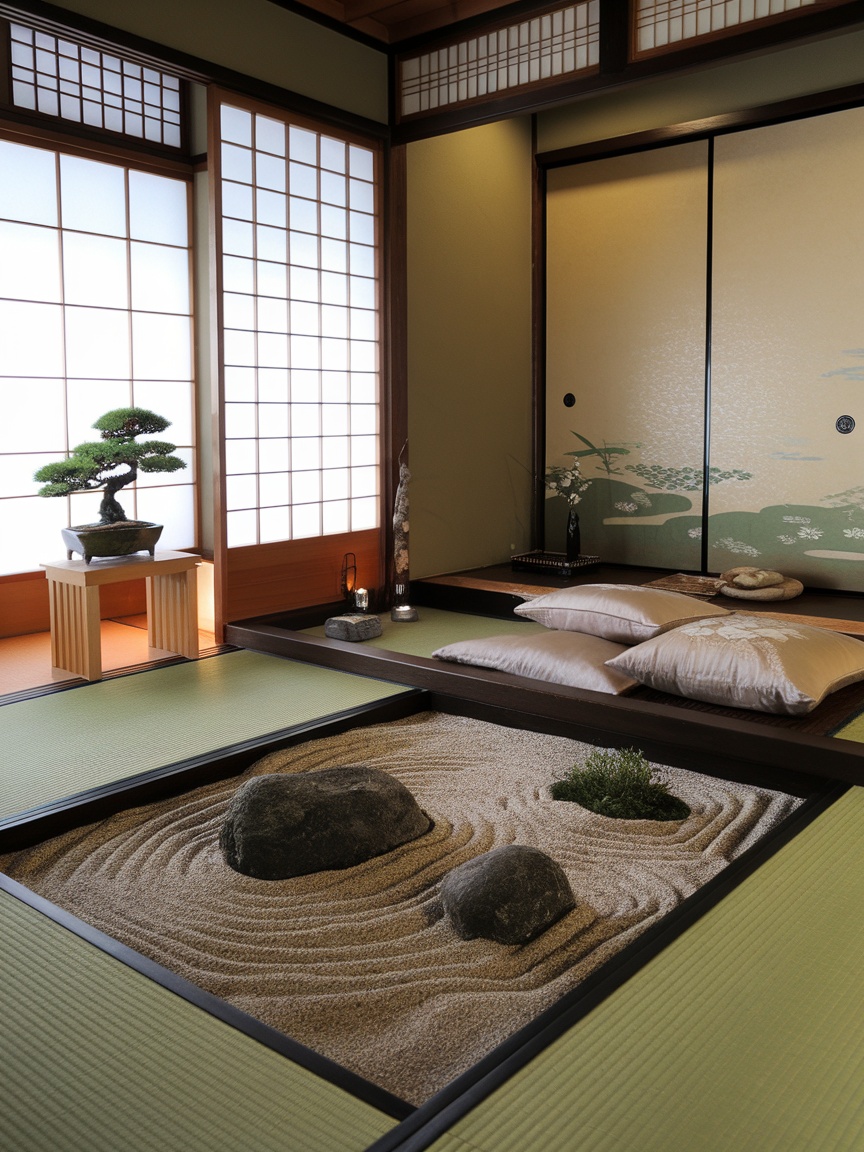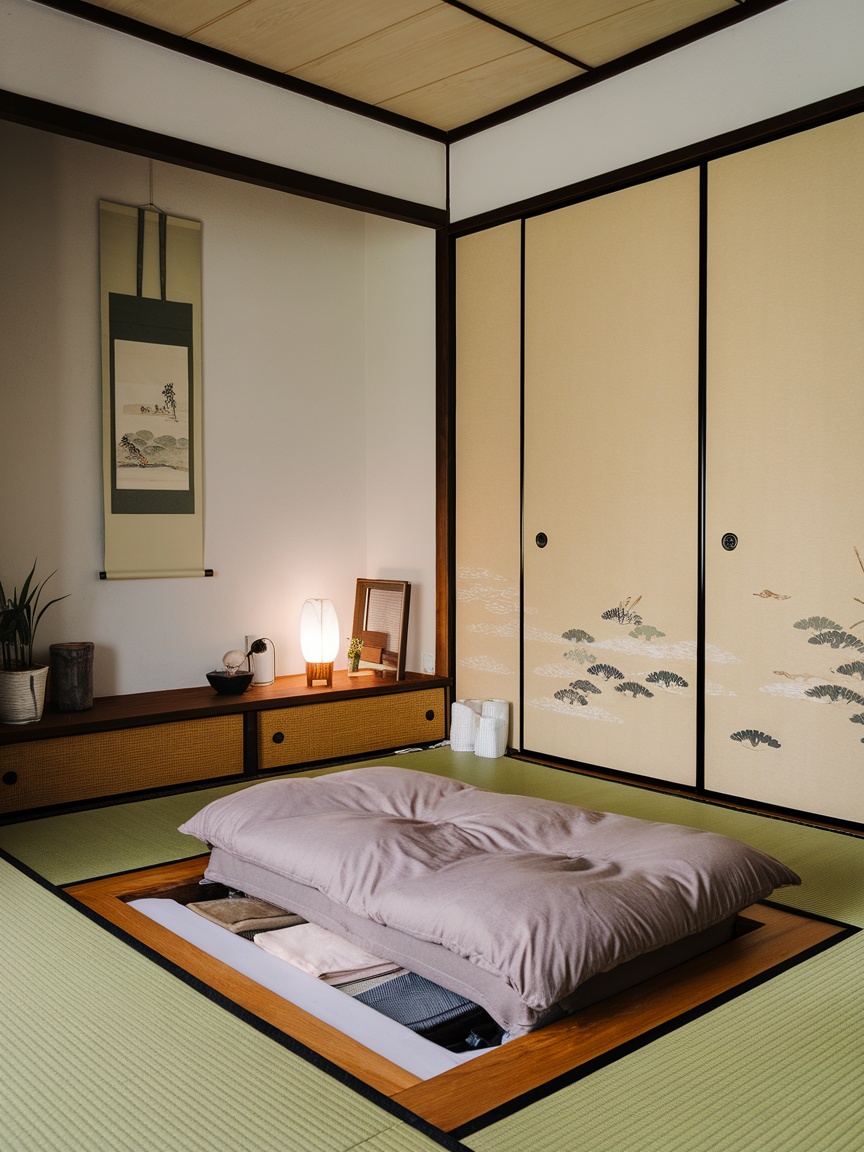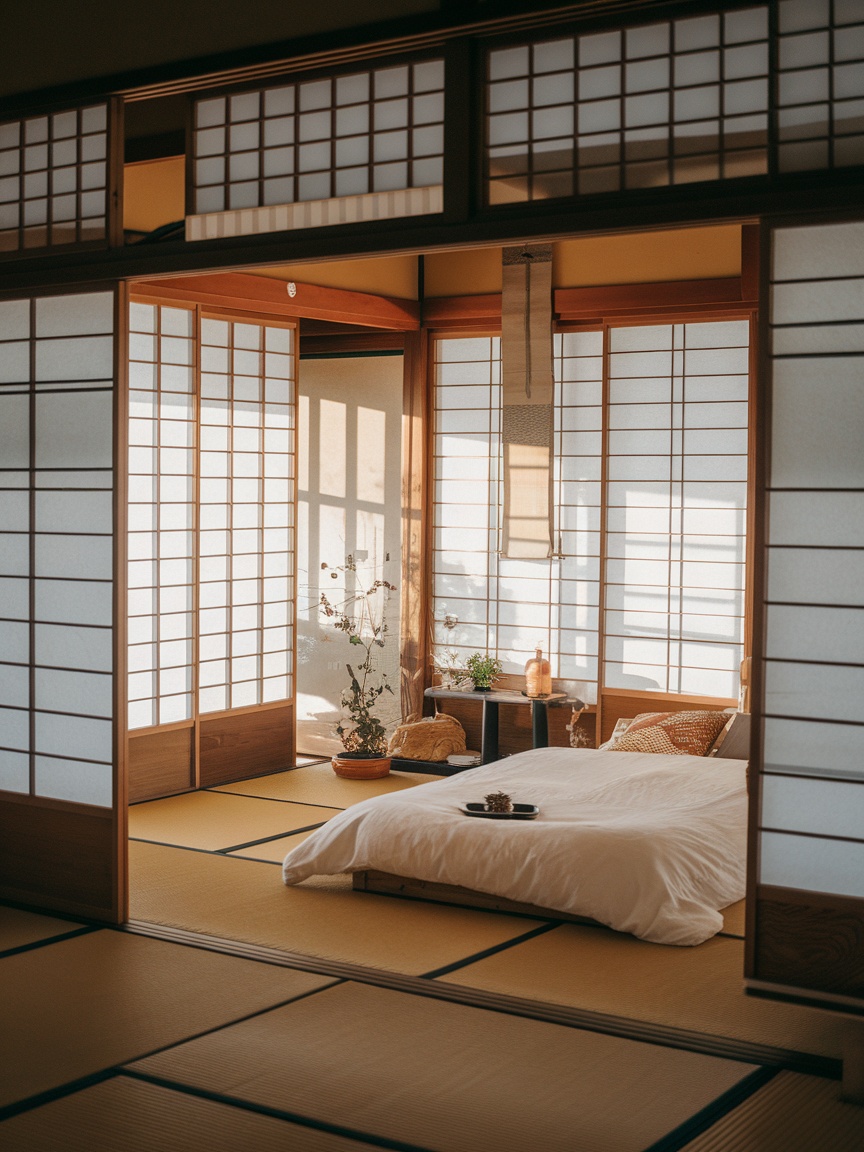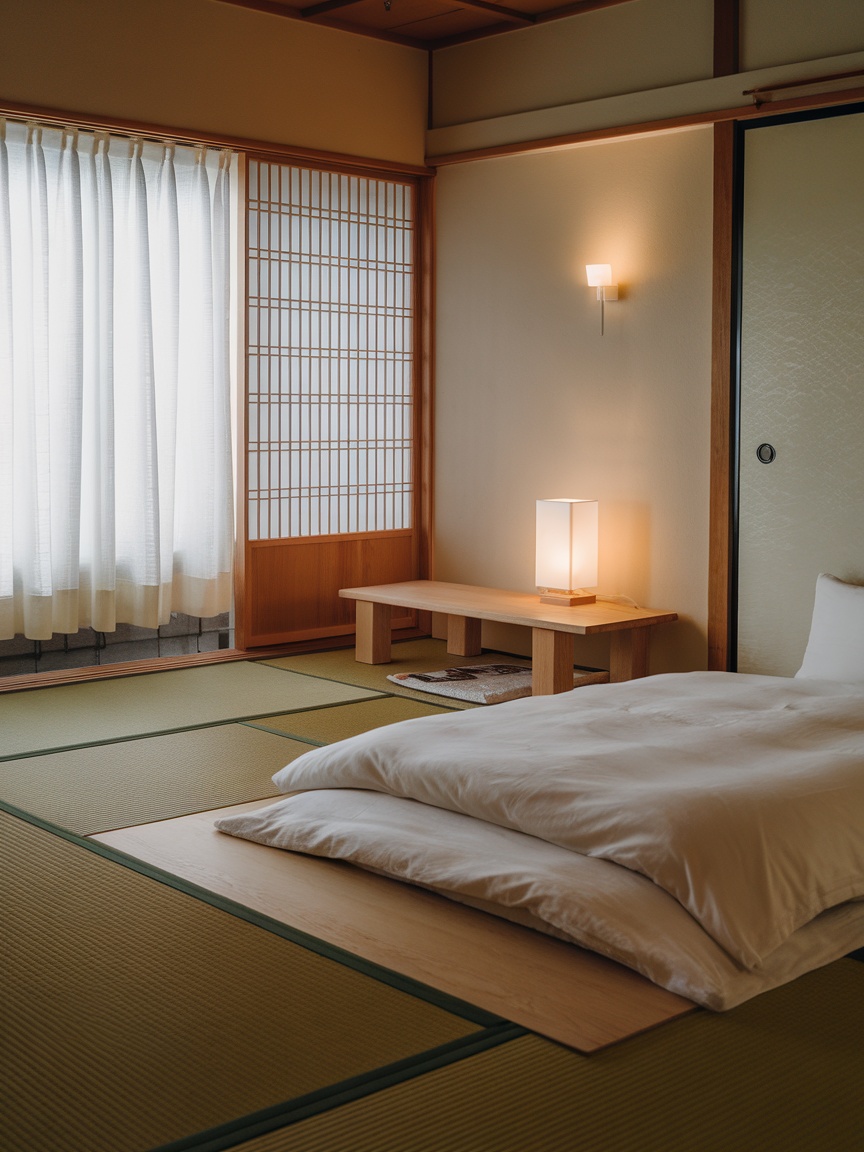The first time I slid open the paper door to my ryokan room in Kyoto, I was struck by an overwhelming sense of peace. Unlike the cluttered, busy spaces I was accustomed to, this traditional Japanese bedroom featured little more than a low futon on tatami mats, a simple wooden table, and a single ikebana flower arrangement. Yet in that minimalist space, I experienced the most restful sleep of my life.
The intentional simplicity, natural materials, and thoughtful design elements created an atmosphere that fundamentally shifted my understanding of what a bedroom could be—not just a place to sleep, but a sanctuary for the mind and spirit.


This transformative power of Japanese bedroom design has inspired countless homeowners around the world to incorporate these principles into their own spaces. Whether you’re looking to create an authentic Japanese bedroom or simply infuse your existing space with Japanese-inspired elements, this comprehensive guide will walk you through everything you need to know to create your own peaceful retreat.
What Is a Japanese Bedroom?
A Japanese bedroom, traditionally called a washitsu, is characterized by minimalism, natural materials, and a deep connection to nature. Unlike Western bedrooms filled with furniture and decorative items, authentic Japanese bedrooms embody the philosophy of “ma”—the meaningful use of empty space.
Traditional Japanese bedrooms feature:
- Futons (shikibuton) placed directly on tatami flooring rather than elevated beds
- Tatami mats made from rice straw with woven rush grass covering
- Shoji screens (translucent paper doors) that filter natural light
- Low furniture that maintains the horizontal emphasis of the space
- Natural materials including wood, paper, bamboo, and stone
- Subdued color palettes derived from nature
- Minimal decorations with each item having purpose and meaning
At its essence, a Japanese bedroom is designed around principles of functionality, simplicity, and harmony with nature—creating spaces that calm the mind and rejuvenate the body.

Essential Elements of Japanese Bedroom Design
Tatami Flooring
The foundation of any authentic Japanese bedroom is tatami flooring:
- Made from compressed rice straw cores with rush grass coverings
- Sized in standardized proportions used to measure room dimensions (typically 3×6 feet)
- Provides natural air purification and humidity regulation
- Offers a slightly springy, comfortable surface for sleeping futons
- Emits a subtle, fresh grassy scent characteristic of traditional Japanese homes
While authentic tatami can be expensive and requires special maintenance, modern alternatives include tatami-style mats that can be placed over existing flooring for a similar aesthetic with easier upkeep.

Futon Bedding
Unlike thick Western mattresses on bed frames, traditional Japanese sleeping arrangements consist of:
- Shikibuton – a thin cotton mattress placed directly on tatami
- Kakebuton – a light duvet or comforter
- Makura – small, firm pillows filled with beans, buckwheat hulls, or plastic beads
Japanese futons are stored in closets (oshiire) during the day, opening up the room for other activities—exemplifying the multifunctional use of space central to Japanese design.

Sliding Doors and Screens
Japanese bedrooms utilize various types of sliding partitions:
- Shoji – translucent paper screens that filter light while maintaining privacy
- Fusuma – opaque paper sliding doors often decorated with paintings or calligraphy
- Byobu – folding screens used as room dividers or decorative elements
These elements create flexible spaces that can be reconfigured according to needs while maintaining the flow of light and air throughout the home.

Natural Materials and Textures
Japanese bedroom design embraces materials in their natural state:
- Unfinished or lightly finished woods like hinoki (cypress), sugi (cedar), and pine
- Plant fibers including cotton, linen, rush, and bamboo
- Paper elements used in shoji screens, lanterns, and decorative items
- Stone incorporated in decorative elements or garden views
These materials connect the bedroom to the natural world while aging beautifully, developing character and patina over time.

Japanese Color Palettes
Traditional Japanese bedrooms feature subdued, natural color schemes:
- Neutral base colors including sand, ivory, and various shades of wood
- Earthy accents like moss green, slate blue, and clay red
- Black accents providing grounding contrast through furniture or decorative elements
These palettes create a serene backdrop that promotes rest and relaxation while allowing natural materials to take visual precedence.

How to Design a Japanese Bedroom
Creating an authentic Japanese bedroom involves thoughtful planning and design choices:
Space Planning and Layout
Begin with these foundational considerations:
- Embrace minimalism by removing unnecessary furniture and items
- Keep the floor as open as possible with furniture against walls
- Maintain low sight lines with furniture no higher than necessary
- Create symmetry and balance through thoughtful placement
- Consider natural lighting patterns when arranging sleeping areas
The ideal Japanese bedroom feels spacious regardless of its actual dimensions, with careful attention paid to balance and proportion.

Essential Furniture Pieces
Limit furniture to essential items that serve clear purposes:
- Platform bed or futon placed centrally or against a non-window wall
- Low storage chest (tansu) for clothing and personal items
- Small side table for a tea set or reading materials
- Floor cushions (zabuton) for seating
- Low writing desk (optional) for study or correspondence
Each piece should be chosen with intention, featuring clean lines and natural materials that complement the overall aesthetic.

Lighting Considerations
Japanese bedrooms use layered, indirect lighting:
- Natural light filtered through shoji screens
- Paper lanterns (andon) providing soft, diffused illumination
- Floor lamps with paper or fabric shades
- Recessed lighting (in contemporary interpretations)
- Candles for special occasions or evening relaxation
Avoid harsh overhead lighting in favor of softer sources positioned at low and mid-heights to maintain the room’s horizontal emphasis.

Japanese Bedroom Ideas for Different Spaces
Japanese Bedroom Ideas for Small Spaces
Japanese design principles work exceptionally well in compact areas:
- Utilize multifunctional furniture like storage platforms for bedding
- Install sliding doors to eliminate the space needed for door swings
- Incorporate wall storage to keep floor space open
- Use lighter colors on walls and floors to enhance spaciousness
- Select appropriately scaled furniture that doesn’t overwhelm the room
Small spaces particularly benefit from the Japanese emphasis on “ma”—the beauty of empty space—making them feel more generous than their square footage suggests.

Modern Japanese Bedroom Adaptations
Contemporary interpretations blend traditional elements with modern conveniences:
- Platform beds with integrated nightstands instead of futons
- Built-in storage that maintains clean lines while maximizing organization
- Simplified shoji-inspired screens using modern materials
- Neutral color schemes with occasional bold accents
- Modern lighting fixtures that reference traditional forms
These adaptations maintain the spirit of Japanese design while accommodating contemporary lifestyles and preferences.
Japanese Style Bedroom for Different Ages
Adapt Japanese bedroom principles for various life stages:
For Children:
- Lower-height furniture for accessibility
- Tatami-style play areas
- Simple futons that develop good sleeping posture
- Natural material toys and storage solutions
For Adults:
- Full platform beds or traditional futons
- Integrated work areas with technology accommodation
- Storage systems for professional attire
- Privacy considerations for couples
For Seniors:
- Enhanced lighting for visibility
- Supportive sleeping surfaces
- Accessible storage solutions
- Elimination of trip hazards
Japanese design principles can be adapted to accommodate changing needs while maintaining aesthetic integrity.

Japanese Bedroom Decor Ideas
Wall Treatments
Japanese bedroom walls typically feature subtle, textural finishes:
- Shoji screens used as architectural elements or room dividers
- Neutral paint colors in matte finishes
- Wood paneling installed horizontally or vertically
- Textured wallpapers resembling natural materials like grasscloth or rice paper
- Washi paper treatments for accent areas
Avoid busy patterns or bold colors that might disrupt the room’s tranquility.
Decorative Elements
Select minimal décor with significant meaning:
- Ikebana flower arrangements emphasizing form and space
- Bonsai trees bringing living nature into the space
- Calligraphy scrolls (kakemono) displayed in the tokonoma (alcove)
- Ceramic vessels showcasing traditional craftsmanship
- Natural element displays like interesting stones or wood pieces
Each item should be carefully chosen and thoughtfully placed, following the principle that “less is more.”

Textiles and Soft Elements
Incorporate textiles that enhance comfort while maintaining aesthetics:
- Cotton and linen bedding in neutral colors
- Bamboo or linen window treatments providing privacy without blocking light
- Simple cushions in natural fabrics for seating areas
- Wool or cotton rugs with subtle patterns (in contemporary adaptations)
- Noren curtains used as space dividers or decorative elements
Choose natural fibers with minimal patterns, focusing on texture rather than visual complexity to add interest.
Contemporary Japanese Bedroom Design
Modern interpretations balance traditional principles with contemporary needs:
Blending Traditional and Modern Elements
Create harmony between old and new through:
- Clean-lined furniture that references traditional forms
- Technology integration that remains discreet when not in use
- Hidden storage solutions that maintain visual simplicity
- Material contrasts like traditional woods against modern metals
- Statement lighting that serves as functional art
Successful contemporary Japanese bedrooms honor traditional principles while acknowledging modern lifestyle requirements.

Japanese Minimalism in Modern Contexts
Apply Japanese minimalist philosophy to contemporary spaces:
- Curate possessions to include only those that are useful or meaningful
- Embrace negative space as a design element rather than a void to fill
- Select multifunctional items that serve several purposes
- Create visual “breathing room” around furniture and décor
- Establish clear zones for different activities without physical barriers
This approach creates bedrooms that feel intentional and peaceful regardless of size or architectural style.
Technology Integration in Japanese Bedrooms
Incorporate modern necessities without disrupting harmony:
- Hidden television solutions behind sliding panels or artwork
- Wireless charging stations integrated into nightstands
- Smart lighting systems programmable for different moods
- Minimalist sound systems with discreet speakers
- Climate control integrated with traditional elements like ceiling fans
The goal is maintaining the essence of Japanese simplicity while accommodating contemporary conveniences.

Japanese Style Bedding and Textiles
Traditional Japanese Bedding Components
Authentic Japanese bedding consists of layered elements:
- Shikibuton (base mattress) approximately 3 inches thick
- Kakebuton (duvet) filled with silk or modern alternatives
- Taoruketto (light blanket) used during warmer seasons
- Makura (pillow) smaller and firmer than Western counterparts
- Mofu (blanket) for additional warmth when needed
These components work together as a system, easily stored during the day to transform the bedroom into a multipurpose space.
Modern Adaptations of Japanese Bedding
Contemporary interpretations offer greater convenience:
- Platform beds with memory foam mattresses in Japanese proportions
- Minimalist bedding in natural fibers and neutral colors
- Lower-profile box springs or platform supports
- Buckwheat or memory foam pillows that reference traditional forms
- Organic cotton and bamboo fabrics for eco-conscious consumers
These adaptations maintain the aesthetic and functional principles of Japanese bedding while offering familiar comfort.

Textile Selection and Care
Choose and maintain appropriate textiles:
- Select natural fibers like cotton, linen, silk, and wool
- Opt for minimal or geometric patterns if solid colors seem too plain
- Consider seasonal textiles that change with weather conditions
- Follow proper care instructions for traditional materials like tatami
- Air bedding regularly following Japanese practices for freshness
Well-chosen and properly maintained textiles contribute significantly to the sensory experience of a Japanese bedroom.
Japanese Themed Bedroom Ideas
Create cohesive themed spaces with these approaches:
Nature-Inspired Japanese Bedrooms
Bring elements of Japanese landscapes indoors:
- Bonsai and moss gardens as living art
- Water features with subtle sound elements
- Stone arrangements referencing traditional gardens
- Wood elements showcasing natural grain patterns
- Views framed like living paintings through windows or screens
These elements connect the bedroom to nature, essential in Japanese design philosophy.
Zen Buddhist Influences
Incorporate principles from Zen temples:
- Meditation spaces with cushions and simple altars
- Asymmetrical balance in furniture arrangement
- Monochromatic color schemes promoting contemplation
- Empty space as an intentional design element
- Single focal points that encourage mindfulness
These features create bedrooms that function as spaces for spiritual renewal as well as rest.

Regional Japanese Style Variations
Different regions of Japan offer distinct design elements:
- Hokkaido-inspired interiors featuring heavier woods and textiles for colder climates
- Okinawan influences with brighter colors and subtropical materials
- Kyoto machiya elements including fine woodwork and intimate proportions
- Tokyo modern approaches combining urban sophistication with traditional principles
- Rural farmhouse (minka) features with exposed wooden beams and rustic materials
Drawing from specific regional traditions adds depth and authenticity to Japanese-themed bedrooms.
Japanese Interior Design Bedroom Principles
Wabi-Sabi Philosophy
Embrace the beauty of imperfection and transience:
- Appreciate natural aging processes in wood and other materials
- Select handcrafted items with visible evidence of the maker’s hand
- Incorporate asymmetry and natural imperfections
- Value simplicity over ornate decoration
- Find beauty in subtle details rather than grand statements
Wabi-sabi creates bedrooms that feel authentic, personal, and deeply restful.
Balance and Harmony
Create equilibrium through thoughtful design:
- Balance light and dark elements (in keeping with yin-yang principles)
- Create visual weight distribution that feels intentional
- Consider the relationship between objects rather than just the objects themselves
- Maintain proportion between furniture pieces and room dimensions
- Harmonize colors through limited palettes with subtle variations
These principles ensure the bedroom feels cohesive and peaceful rather than disconnected or chaotic.
Biophilic Connections
Strengthen connections to nature through:
- Natural light managed through shoji or other window treatments
- Views of nature incorporated whenever possible
- Natural materials used throughout the space
- Plant life in simple, thoughtful arrangements
- Natural sounds like flowing water or wind chimes
This connection to nature helps regulate circadian rhythms and promotes better sleep quality.
DIY Japanese Bedroom Projects
Creating Shoji Screens and Doors
Make adaptable shoji elements:
- Materials needed: Wooden lattice strips, rice paper or translucent acrylic, wood frame materials
- Basic process: Create wooden grid, attach to frame, cover with paper or alternative material
- Placement options: Window coverings, room dividers, closet doors
- Customization: Various grid patterns, paper colors, and frame styles
- Maintenance: Regular dusting and occasional paper replacement
Custom shoji elements add authentic Japanese character while serving practical purposes.

DIY Platform Bed and Storage Solutions
Build space-efficient furniture:
- Simple platform bed with storage drawers underneath
- Low bookshelf doubling as room divider
- Wall-mounted bamboo clothing rack as alternative to closets
- Floating shelves for minimal visual impact
- Tatami platform raised slightly from floor level
These projects can be adapted to various skill levels and customized to fit specific spaces.
Budget-Friendly Japanese Decor Ideas
Transform spaces without significant investment:
- Paper lantern lighting creating soft illumination
- Bamboo window blinds replacing conventional treatments
- Furoshiki fabric wrapping for decorative storage
- Painted folding screens serving as art and room dividers
- Repurposed natural elements like interesting branches or stones
These accessible projects allow experimentation with Japanese aesthetics before committing to larger investments.
Common Questions About Japanese Bedrooms
Are Futons Comfortable for Everyday Use?
Traditional Japanese futons offer different but often superior comfort:
- Proper support: Firm enough to maintain spinal alignment
- Adaptability: Can be folded to provide different levels of support
- Body temperature regulation: Natural materials prevent overheating
- Adjustment period: Most users require 1-2 weeks to fully adapt
- Western adaptations: Slightly thicker versions available for easier transition
Regular airing and proper storage extend futon life while maintaining comfort and hygiene.
How to Incorporate Japanese Elements in Western Homes?
Adapt Japanese principles to existing architecture:
- Focus on creating tranquil atmosphere rather than strict authenticity
- Incorporate key elements like natural materials and minimalism
- Address architectural limitations through creative solutions
- Balance Japanese influences with existing architectural features
- Prioritize functionality over perfect aesthetic replication
Successful integration focuses on principles rather than literal recreation of Japanese spaces.
How to Maintain Tatami and Natural Materials?
Preserve the beauty and function of natural elements:
- Regular airing of tatami and bedding
- Gentle cleaning using appropriate methods for each material
- Moisture control through proper ventilation
- Sunlight management to prevent fading
- Seasonal care routines addressing changing environmental conditions
With proper maintenance, natural materials develop character while remaining functional for many years.
The Psychology of Japanese Bedroom Design
How Japanese Bedrooms Improve Sleep Quality
Research suggests Japanese-style bedrooms enhance rest:
- Reduced visual stimulation decreases cognitive activity before sleep
- Natural materials regulate humidity and temperature
- Minimal electromagnetic exposure from reduced electronics
- Connection to natural light cycles helps regulate circadian rhythms
- Clear boundaries between sleep and wakeful activities
These elements address common sleep disruptors present in many contemporary bedrooms.
Mental Health Benefits of Japanese Design Principles
Japanese bedroom environments positively impact wellbeing:
- Reduced visual clutter decreases stress and cognitive load
- Natural elements provide proven biophilic benefits
- Intentional simplicity encourages mindfulness and presence
- Sensory-conscious design creates restorative environments
- Connection to tradition offers psychological grounding
These benefits make Japanese bedrooms particularly valuable in our overstimulated modern world.
Cultivating Mindfulness Through Bedroom Design
Japanese bedrooms support contemplative practices:
- Designated meditation areas encourage regular practice
- Minimal distractions support present-moment awareness
- Intentional aesthetics that invite appreciation
- Natural rhythms reinforced through design elements
- Ritual spaces for tea preparation or other mindful activities
The bedroom becomes not just a place to sleep but a sanctuary for mental restoration.
Conclusion: Creating Your Japanese Sanctuary
The Japanese bedroom offers more than just an aesthetic—it provides a fundamental reimagining of what personal space can be. By embracing principles of simplicity, natural materials, and thoughtful design, you create not just a place to sleep but a sanctuary that supports wellbeing on multiple levels.
Whether you’re drawn to authentic Japanese bedroom design with traditional elements like tatami and futons, or prefer a Japanese inspired bedroom that blends these principles with contemporary needs, the core philosophies remain relevant: minimize the unnecessary, connect with nature, and create intentional spaces that promote both physical rest and mental peace.
The beauty of Japanese bedroom ideas lies in their adaptability—these concepts work equally well in small urban apartments or spacious suburban homes, with modest budgets or generous ones. By thoughtfully incorporating elements that resonate with you personally, you create a bedroom that not only looks beautiful but fundamentally transforms your experience of rest and renewal.
In our increasingly complex and demanding world, the wisdom of Japanese bedroom design offers a compelling alternative—a return to simplicity, mindfulness, and harmony with nature that benefits both body and spirit.




